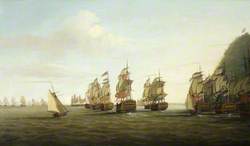How you can use this image
This image can be used for non-commercial research or private study purposes, and other UK exceptions to copyright permitted to users based in the United Kingdom under the Copyright, Designs and Patents Act 1988, as amended and revised. Any other type of use will need to be cleared with the rights holder(s).
Review the copyright credit lines that are located underneath the image, as these indicate who manages the copyright (©) within the artwork, and the photographic rights within the image.
The collection that owns the artwork may have more information on their own website about permitted uses and image licensing options.
Review our guidance pages which explain how you can reuse images, how to credit an image and how to find images in the public domain or with a Creative Commons licence available.
Notes
Add or edit a note on this artwork that only you can see. You can find notes again by going to the ‘Notes’ section of your account.
The Battle of Quiberon Bay was the most decisive naval encounter of the Seven Years War, a conflict involving the major European colonial powers. France had been at war with Britain since 1756; her position in Canada, India and the West Indies was on the point of collapse and in Europe faced stalemate against Prussia, which received British support. The battle occurred when the French broke out of the English blockade of Brest. The French planned to land an army of 20,000 men in Ireland. This force was assembled in the gulf of Morbihan, and was to be escorted by the Brest fleet under Admiral de Conflans. Admiral Sir Edward Hawke's Channel fleet blockaded Brest to prevent the French leaving to collect the troop transports, but during a gale in the first week of November, Hawke's ships were forced to run for shelter in Torbay, giving de Conflans the chance to escape. Hearing that the French had done so, Hawke went in pursuit and, on 20 November, sighted him. De Conflans ordered his fleet to take refuge in Quiberon Bay, south of Morbihan, assuming Hawke would not follow because night was falling and the area was one of ill-charted rocks, reefs and wild seas. This was a miscalculation, for Hawke relentlessly pursued him into the bay, losing two of his own ships but sinking the French 'Thesee' and decimating de Conflans' force in what became an action practically in the dark. The French flagship ‘Soleil Royal’ went aground in the bay and was burnt. Others were captured and the few which managed to escape into the mouth of the River Vilaine were trapped for months. This action stopped any French plans to invade Britain during the War. The famous naval song 'Heart of Oak' was composed to commemorate the battle, which was fought so close inshore that contemporary accounts reported 10,000 persons watched it from the coast.
Title
The Battle of Quiberon Bay, 20 November 1759
Date
1779
Medium
oil on canvas
Measurements
H 114.3 x W 182.8 cm
Accession number
BHC0400
Acquisition method
National Maritime Museum (Greenwich Hospital Collection)
Work type
Painting








